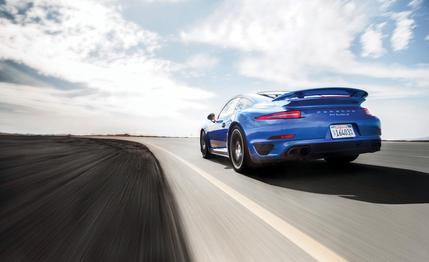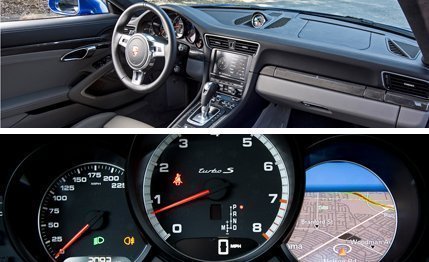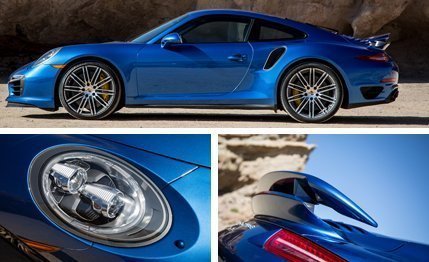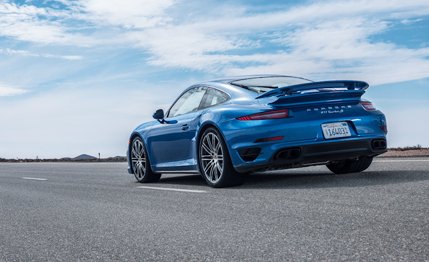
 Instrumented Test
Instrumented Test
Have you ever peeked through the window of a sports car to see what transmission it has? Did you scoff and silently judge the owner for saddling his or her sports car with an automatic? We’ve done that, too. But if you spot a new 911 Turbo on the street, don’t bother peering through the glass; this one only comes with a dual-clutch automatic.
Before you get indignant and throw this magazine at the kid who keeps snapping his gum in the waiting room, you should know that the automatic in the Turbo S is a bright spot in an extraordinary car. Its launch-control function is what puts the Turbo S in the company of the quickest production cars ever built. Launch control isn’t new, but in the Turbo S it makes the most of the car’s 560 horsepower. It gets this 3588-pound machine to 60 mph in 2.6 seconds. That’s just a tenth more than we got when we tested the Bugatti Veyron, and the Turbo S can even put a tenth-of-a-second whupping on a Bug to 30 mph. You can’t fall off a building that fast. At 30 mph, the twin-turbo 3.8-liter flat-six pancakes you into the sport seat with up to 1.37 g’s of acceleration. A run to 100 mph takes 6.5 seconds, only 0.2 second off a McLaren F1’s pace.

 Top: The 911 Turbo S comes only with a PDK automatic trans, but this seven-speed unit enables staggering 0-to-60-mph runs.
Top: The 911 Turbo S comes only with a PDK automatic trans, but this seven-speed unit enables staggering 0-to-60-mph runs.
Unlocking this performance is as easy as pushing the sport-plus button on the center console. Your left foot goes on the brake, and the other stomps the accelerator. A launch-control display comes up on the LCD “gauge” as the rear-mounted six revs to 5600 rpm. Lift off the brake, keep your right foot pegged, and if you have passengers, listen as they start yelping like coyote puppies. All four wheels break loose briefly, and the steering wheel quivers in your hands. In this latest Turbo, more power can be delivered to the front axle because its transfer case is now liquid cooled (air cooling seems so quaint). And extra power to the front wheels means that the Turbo S actually has torque steer—torque steer and four-wheel drive.
Our six acceleration runs from zero to 170 mph (24.8 seconds) were impressively consistent, each within a tenth of a second. The carbon-ceramic brakes (PCCB in Porsche sprache) convert the 911’s kinetic energy into heat with no sign of fade. Stops from 70 mph took only 144 feet. These brutal forces don’t seem to have any impact on the machinery. The clutches didn’t slip or feel any different run to run, nor did the Porsche utter any disconcerting mechanical clunks from its bowels.
There’s nothing you can do to stress the car, and nothing about the Turbo S stresses you. Most supercars draw unwanted attention and are difficult to take on a daily basis. Porsche’s Turbo S is no harder to live with than a regular 911. Front and rear aero aids deploy and retract automatically at speed to stabilize the car, and, at low speed, the front spoiler retracts back into the bumper to avoid being scraped on steep driveways. It’s easy to get in and out of, there’s plenty of glass to look through, leather wraps nearly every bit of interior that isn’t carpeted, and there are even two small jump seats in back should you want to take the kiddos to g-town.


At a starting price of $182,095, Turbo S models come standard with all of the performance options that cost extra on the 520-hp Turbo. Sport Chrono is standard, and, in addition to its ticking clock, you get an overboost function that lifts peak pressure from 17.4 psi to 19.6 psi for 20-second bursts. The engine makes 553 pound-feet of torque, up from 516, during those 20 seconds. Did we mention torque steer?
Other Turbo S standard equipment includes Porsche Dynamic Chassis Control (PDCC), which keeps the car eerily flat in corners. When you’re pointed straight, the dynamic anti-roll bars effectively disconnect to improve ride quality, which is firm but never annoying. PDCC is always on, but it acts faster to combat roll when you push the sport-plus button. Four-wheel steering angles the rear wheels up to 2.8 degrees in opposition to the fronts at speeds below 31 mph to make the car feel smaller and livelier. At higher speeds, the rears pivot up to 1.5 degrees in the same direction as the fronts to stabilize the car in corners. Other handling tricks include Porsche Torque Vectoring Plus (PTV Plus), which clamps the inside rear brake to help rotate the car into a corner while sending more power to the outside wheel.


All the abbreviations work. On the skidpad, we measured a very easy and stable 1.09 g’s. And despite having 60.1 percent of its weight over the rear wheels, there’s no telltale sign of the engine’s location from the driver’s seat (aside from the roaring whoosh coming from behind). Steamroller P Zeros, electronic chassis controls, and four-wheel steering have seemingly defied rear-engine physics.
In typical Porsche fashion, there are still a few options to be had, even on a Turbo S. Our sample car came in at $193,740. Major options included active cruise with collision warning ($2490), keyless start and entry ($1090), extended leather interior ($1710), and, finally, the Burmester sound system with 12 speakers ($3500). There’s another car that has a Burmester stereo and doesn’t offer a manual. It’s called the Bugatti Veyron.